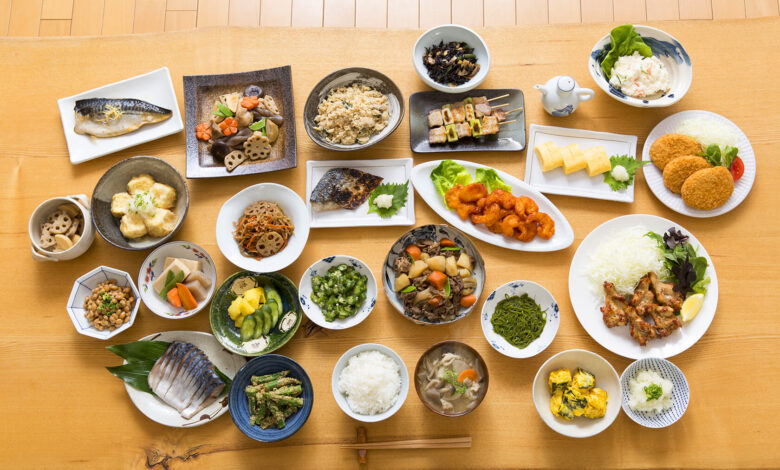Ten dishes you should try in Japan

There are all kinds of noodles, traditional sweets, and street food. When you come for a long time, you have time to choose your favorite dish. But what if time is limited? Use MANABO’s list of Japanese dishes.
Ramen noodles
Ramen – wheat noodles in soup with various toppings – is the dish for which the Japanese most often stand in line. The fact is that it is usually served in small restaurants – ramenya – where there are few seats, sometimes only at the counter. In addition, many noodle shops work only a few hours a day, and spend the rest of the time carefully preparing.
These are often unprepossessing establishments where the interior is not as important as the taste. Chefs work to perfect the broth and noodle recipe, and the ingredients are often kept secret. You could say that there is a cult of ramen in Japan. Guides are published about the best noodle shops, and real fans make pilgrimages to different establishments and compare tastes.
Udon and soba noodles
Udon is also a wheat noodle, but thicker and wider than ramen. Udon is eaten hot or cold, in soup or without, with toppings or on its own, as a main meal or just a snack. Udon is a simpler dish than ramen and is more often prepared at home. The most popular dishes with udon are kitsune udon and tanuki udon. Kitsune means fox, and it’s udon in a hot soup with aburaage, fried tofu.
Aburaage is similar in color to a fox – hence the name. According to another version, fried tofu is a fox’s favorite treat. Tanuki is also hot udon topped with tenkasu, pieces of deep-fried dough. Tanuki is a raccoon dog, but is often translated as “badger.” It is believed that this is a play on words – either from the name of one of the ingredients, or from a popular restaurant. The names of dishes and their preparation often differ in different regions of Japan.

Soba is thin light brown noodles made from buckwheat flour. This is the only way the Japanese eat buckwheat, and they have never even heard of buckwheat porridge. The same dishes are prepared from soba as from udon.
Tonkatsu chop
Tonkatsu is a deep-fried pork chop. Usually in a restaurant you can take as many additions as you want of everything that goes on the side dish. Unfortunately, the pork supplement is not offered for free. The cabbage is served with a very tasty citrus-based dressing. And the meat comes with several types of sauces and mustard. Many restaurants bring sesame seeds in a mortar, which you need to grind and add to the sauce yourself.
Tempura is vegetables, mushrooms, seafood and, less often, meat, which are dipped in batter and deep-fried. They are served with salt or a special sauce – tsuyu. The most popular tempura is made from shrimp. This dish is often served with udon or to go. Most often, tempura is eaten in a restaurant or purchased ready-made in supermarkets. Some people cook it at home, but although this is a simple dish, it is still a troublesome dish: the stove will be splashed with oil, and then a large amount of oil that was used for frying needs to be put somewhere.
Chicken karaage
Karaage is pieces of chicken marinated and deep fried. Karaage remains delicious when cold, which is why it is most often seen in o-bento – lunch boxes – both those prepared at home and those sold in stores and restaurants. They take karaage with them on hanami – a picnic under the cherry blossom trees, on momiji-gari – hiking in search of beautiful autumn maples, it is eaten on the Shinkansen high-speed train and at undokai – sports festivals at school. In addition, this is one of the Japanese favorite snacks for drinking.
Teppanyaki meat and vegetables
Teppanyaki is an exquisite and expensive dish. It is eaten on special occasions in high-end restaurants, where it is better to make a reservation in advance. In teppanyaki, not only the taste is important, but also the cooking process, which is interesting to watch.

The cook fries the highest quality meat, seafood and vegetables on a wide frying pan (more precisely, it’s just a flat iron surface) right in front of the customers, sometimes tossing or juggling the ingredients. The most spectacular moment is when a large tongue of flame rises high to the enthusiastic exclamations of the guests. Teppanyaki is ordered as a course, which consists of several main courses, a side dish and a dessert. The cost per person averages from $100 and above.
Japanese okonomiyaki pizza
Okonomiyaki is also prepared on teppan – “iron sheet”. But this is a more affordable dish both in terms of prices and atmosphere in restaurants. Okonomiyaki is often called Japanese pizza or pancake because it is round and flat. The main ingredients are finely shredded cabbage, egg and flour, from which the dough is made. All this is fried, putting various toppings on top – most often meat and seafood. The finished okonomiyaki is poured with a special sauce.
mayonnaise and sprinkled with dry green aonori seaweed and katsuobushi fish shavings, which, when exposed to high temperatures, begin to move like a living creature. The name “okonomiyaki” can be translated as “fry to taste”, because the toppings for it can be whatever you want – for example, whatever you have lying around in the refrigerator if the dish is prepared at home.
Like teppanyaki, okonomiyaki is prepared in front of the customer in restaurants. Sometimes visitors fry okonomiyaki themselves on an iron surface on the table, at the same time entertaining themselves with the cooking process. This dish comes from western Japan – the city of Osaka, which is famous for its delicious food and food lovers.

